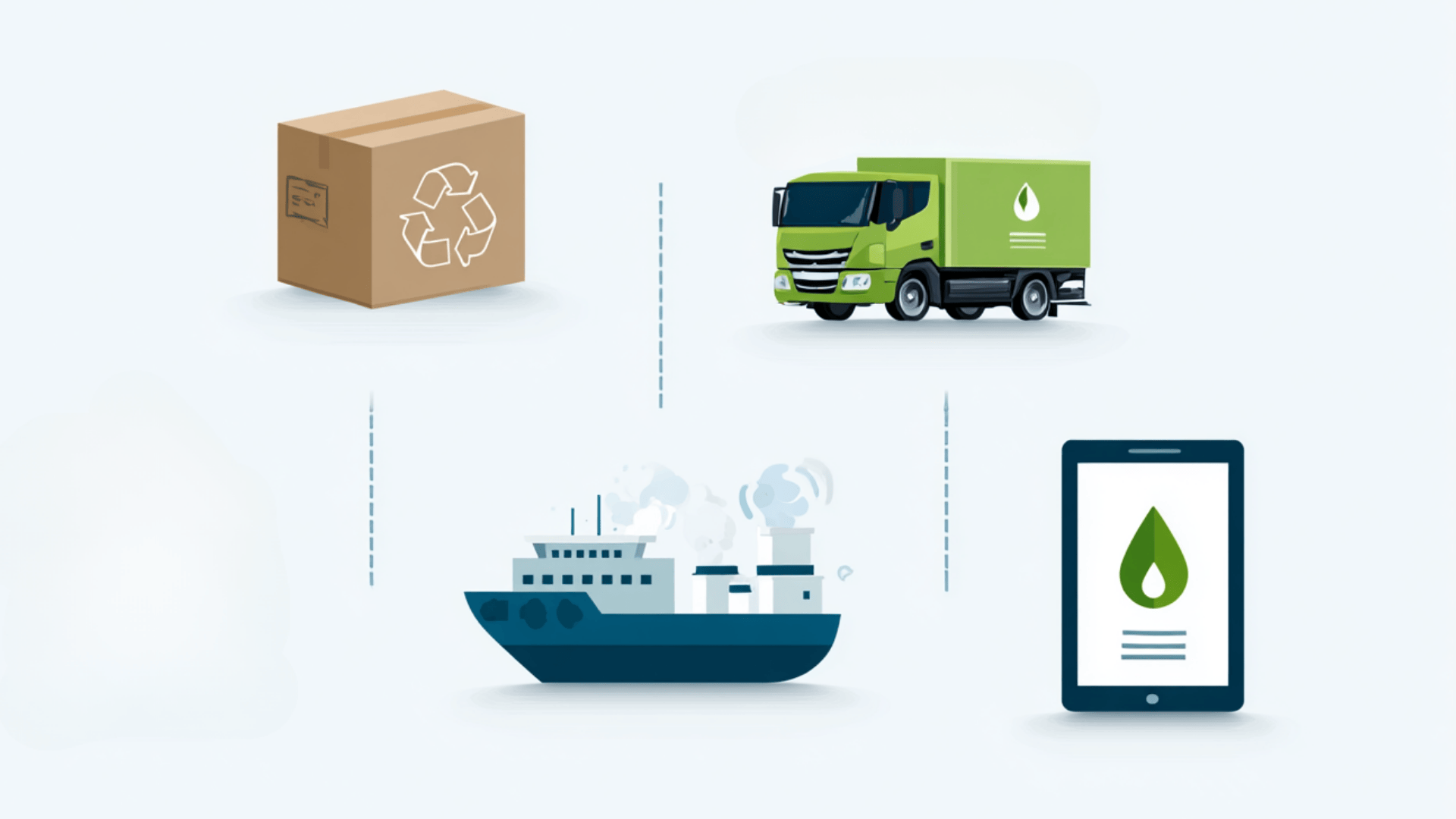Shipping keeps the world connected, but behind every package and container lies a cost we don’t always see.
Fuel use, waste, and port activity all leave a lasting mark on the planet. That’s why the push for sustainable shipping is becoming more urgent.
It’s not just a trend; it’s a shift in how the industry thinks about responsibility, efficiency, and long-term growth.
I’ve noticed that the real question isn’t whether shipping can become sustainable, but how quickly it can happen, and who will lead the change.
Understanding what this shift really means helps set the stage for everything that follows.
Sustainable Shipping: What It is and Why It Matters
When people talk about shipping, they often focus only on cost and speed. But there’s another side that matters just as much, how it affects the planet and the people involved. That’s where sustainable shipping comes in.
Sustainable shipping isn’t the same as “green shipping.” Green shipping usually focuses only on the environment, like cutting fuel use or lowering carbon emissions.
Sustainable shipping goes further. It looks at the bigger picture, including the environment, the well-being of workers, and the long-term health of the industry.
This idea also ties directly to the United Nations Sustainable Development Goals (SDGs).
These global goals encourage industries, including shipping, to reduce their environmental footprint, improve working conditions, and build practices that last.
Key Pillars of Sustainable Shipping
Sustainable shipping has three main areas that work together.
Environmental: This side focuses on cutting emissions, reducing water and air pollution, and improving the full lifecycle of ships, from how they’re built to how they’re recycled.
Social: It’s not just about the ships. Crew members need safe working conditions, fair treatment, and support for their health. Local communities near ports also benefit when shipping is done responsibly.
Economic: For shipping to last, it has to make sense financially. That means improving efficiency, lowering long-term costs, and following global rules that keep the industry competitive and compliant.
Best Practices in Sustainable Shipping

There are many ways to make shipping more sustainable. Some focus on fuel, others on how goods are packed and moved. Together, these steps reduce harm to the environment while keeping shipping efficient and cost-friendly.
1. Alternative Fuels & Propulsion
One of the biggest shifts in shipping is moving away from traditional fuels. Hydrogen, methanol, and biofuels are being tested as cleaner options.
Some ships are even using electric power for short routes. These changes cut emissions and set the stage for a lower-carbon future.
2. Operational Strategies
How a ship moves can be just as important as what it runs on.
- Slow steaming means traveling at lower speeds to burn less fuel.
- Route optimization uses data to find the shortest and most efficient path.
- Consolidation allows multiple orders to ship together, which reduces the number of trips.
Each of these strategies helps lower costs while reducing environmental impact.
3. Packaging Innovations
What goods are shipped in makes a difference, too. Companies are turning to:
- Biodegradable materials that break down faster and leave less waste.
- Right-sized packaging that reduces empty space and extra material.
- Recycled content that gives materials a second life instead of sending them to landfills.
Smarter packaging means less waste, lighter loads, and cleaner oceans.
4. Ports & Infrastructure
Sustainable shipping doesn’t stop at sea. Ports are making changes to become greener, such as:
- Building green ports that use renewable energy and reduce local pollution.
- Offering shore power, which lets ships plug in while docked instead of burning fuel.
- Investing in renewable energy systems to power operations.
These upgrades improve air quality and cut emissions in busy port areas.
5. Digitalization & Data Analytics
Data plays a huge role in shipping today.
- Tracking systems monitor cargo and vessel movements in real time.
- Fuel monitoring tools show where energy is wasted and how to save.
- AI-powered routing helps ships avoid delays, bad weather, and fuel-heavy paths.
Digital tools give shipping companies the insights they need to operate smarter and greener.
Benefits of Sustainable Shipping
Sustainable shipping isn’t just good for the planet. It also creates real advantages for businesses and customers.
- Cost savings: Using less fuel, reducing waste, and improving packaging all add up to lower operating costs. Even small changes can make a noticeable difference over time.
- Efficiency gains: Smarter routes, slower speeds, and digital tools help ships run more smoothly. This means fewer delays, less downtime, and better use of resources.
- Compliance with IMO/EMSA/SDG: Global rules from organizations like the IMO and EMSA are getting stricter. Companies that focus on sustainability now are better prepared to meet these standards and avoid penalties later.
- Improved brand image and customer loyalty: More customers want to support businesses that care about the environment. Showing a clear commitment to sustainable shipping can build trust and keep people coming back.
When shipping is done responsibly, it’s a win for the environment, the industry, and the people who rely on it.
Barriers and Challenges
While sustainable shipping has clear benefits, it’s not always easy to put into practice. Businesses and ports face a few big challenges along the way.
- High initial investment: Switching to cleaner fuels, upgrading ports, or buying new ship designs can be expensive. The upfront costs are often a hurdle, especially for smaller companies.
- Fuel supply and infrastructure gaps: Alternative fuels like hydrogen and methanol aren’t available everywhere yet. Without the right supply networks, it’s hard for ships to fully rely on them.
- Regulatory complexity: Different countries follow different rules, and keeping up with international standards can be complicated. This makes global adoption slower.
- Industry-wide adoption hurdles: One company making changes isn’t enough. Sustainable shipping needs cooperation across shipping lines, ports, and suppliers, which takes time and commitment.
Even with these barriers, progress is being made. Step by step, the industry is finding ways to overcome these challenges.
Real-World Examples of Sustainable Shipping
Many companies, ports, and organizations are already making changes that show what’s possible.
| Area | What’s Happening | Impact |
|---|---|---|
| Ports | Moving toward fully green operations by using renewable energy, offering shore power, and cutting emissions in nearby communities. | Improves local air quality and makes port operations more efficient. |
| Packaging | Businesses are using suppliers like EcoEnclose that provide recycled and compostable materials. | Reduces waste before products leave the warehouse and makes shipping more sustainable. |
| Shipping Companies | Testing low-carbon fuels, upgrading vessels for efficiency, and offering carbon offset programs. | Lowers emissions while keeping goods moving reliably worldwide. |
| Governments & Industry Groups | Organizations like IMO and EMSA are setting global standards and supporting projects such as green shipping corridors. | Creates industry-wide cooperation and makes it easier for companies to follow sustainable practices. |
Together, these examples prove that sustainable shipping isn’t just a concept. It’s already happening, and each step creates a model for others to follow.
How Businesses Can Adopt Sustainable Shipping

No matter the size of your business, there are ways to make shipping more sustainable. Some steps are small and low-cost, while others involve bigger changes that create long-term impact.
For SMEs: Practical, affordable steps
If you’re running a small or mid-sized business, the easiest place to start is packaging. Switching to recycled or compostable materials doesn’t just cut waste, it also shows customers you care about sustainability.
Consolidating shipments can save money and reduce fuel use, while choosing ground shipping over air whenever possible lowers emissions. These simple changes don’t require huge investments but can make a real difference over time.
For Large Enterprises: Scaling impact
Bigger companies have more resources, which means they can take bigger steps. Investing in alternative fuels, upgrading fleets to more efficient vessels, and partnering with green ports are all strategies that can create measurable results.
At scale, these changes don’t just improve efficiency; they also set an example for the rest of the industry. Large enterprises can use their buying power to push suppliers and partners toward greener practices, too.
Tools and Certifications: Carbon Calculators, eco-labels
Both small and large businesses can benefit from tools that measure and track progress. Carbon calculators help you see exactly how much emissions come from shipping and where you can cut back.
Eco-labels and certifications make it easy to share your sustainability efforts with customers. Having clear data and trusted certifications builds credibility and shows that your shipping practices aren’t just talk; they’re verified.
Future of Sustainable Shipping
Sustainable shipping is still evolving, and the next few years will bring even bigger changes. Technology, global agreements, and new fuels are shaping what the future will look like.
AI and automation are already playing a role. Smarter routing systems, automated loading equipment, and smart ports are helping ships move more efficiently with less waste. These tools cut costs while also lowering emissions.
Global regulations and treaties are another big driver. As countries agree on stricter climate targets, the shipping industry will need to adapt quickly. This will mean tougher standards but also more support for companies that invest in cleaner practices.
New fuels like hydrogen and methanol are gaining ground, while green shipping corridors link ports with higher sustainability standards. These efforts highlight how global cooperation can drive lasting change.
The future of shipping is heading toward cleaner, smarter, and more connected systems. The changes won’t happen overnight, but each step brings the industry closer to a sustainable path.
Conclusion
Sustainable shipping isn’t just about cleaner fuels or smarter packaging; it’s about reshaping the way goods move across the world.
What I find most encouraging is how collaboration between ports, businesses, and regulators is creating a shared momentum that can’t be ignored.
The shift also brings fresh opportunities for innovation, from smarter trade routes to new partnerships that strengthen supply chains.
For companies, the choice isn’t simply about keeping up with rules; it’s about staying competitive in a market where your customers care about responsibility as much as speed.
If you’re like me and want practical ideas you can apply right away, read more of my blogs on sustainability and logistics for practical tips you can use today.















